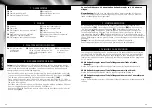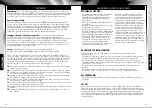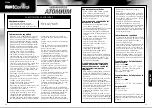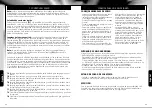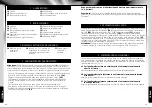
English
English
18
19
SUITABLE FLYING ENVIRONMENT:
The location in which the quadrocopter is flown should fulfil the following criteria:
• It should be an indoor location without any wind.
Heating fans, air condition systems or similar equipment cause air flows that could
disrupt flight.
• The room should be at least 10 metres long, six metres wide and three metres high.
For stunt flying, we recommend flying outdoors or in a large hall with at least 10 m
in each direction.
• There should not be any objects in the room which could be damaged.
• When flying, make absolutely sure that all persons and animals - including the
pilot - are at least 1-2 metres removed from the aircraft before flight begins.
INSTRUCTIoNS FoR SAFE FLYING
GENERAL FLYING TIPS:
• Always place the quadrocopter on a level
surface. An inclined surface can, under
certain circumstances, have a negative
impact on the starting behaviour of the
quadrocopter.
• Always operate the controls slowly and
with a gentle touch.
• Always maintain visual contact with the
quadrocopter and do not look at the
remote control!
• Move the thrust control down again
somewhat as soon as the quadrocopter
lifts off from the ground. Maintain flying
altitude by adjusting the thrust controller.
• If the quadrocopter lowers, move the
thrust control slightly upward again.
• If the quadrocopter climbs, move the
thrust controller down slightly.
• To fly along a curve, tapping the
directional controller very slightly in the
respective direction often suffices. There
is a general tendency during preliminary
attempts at flight to operate the
quadrocopter's controls too aggressively.
Always operate the controls slowly and
carefully. Never fast and fitfully.
• Beginners should first master trimming
before attempting to master the thrust
controller. The quadrocopter does not
necessarily have to fly straight at the
beginning - initially, it is more important
to maintain a constant height of
approximately one metre above the
ground by repeatedly tapping the thrust
control. Only then should the pilot
practice steering the quadrocopter left
and right.
BATTERY STATUS:
• If the quadrocopter begins to lose thrust, the battery is depleted.
Land immediately in order to avoid crashing.
Flying model aircraft and helicopters outdoors has required mandatory liability
insurance since 2005. Contact your private liability insurer and make sure that your
new and earlier models are included in your insurance coverage. Request written
confirmation and keep this in a safe place. Alternatively, the DMFV offers a trial
membership free of charge online at www.dmfv.aero, which includes insurance.
WARNING!
7 FLIGhT CoNTRoL
Note:
Only minimal corrections of the controls are necessary for a smooth flying
behaviour of the quadrocopter! The direction information applies if the quadrocopter is
viewed from behind. If the quadrocopter is flying towards the pilot, it must be moved
in the opposite direction.
Higher flight speed
For increased flight speed, press the Speed button
(7I)
to the left of the display.
Now the quadrocopter takes on increased tilt in order to enable higher flight speeds.
Please only use this function after gaining sufficient experience in the standard setting,
because the quadrocopter reacts very sensitively and must be controlled with care.
Pressing the button again switches the quadrocopter back to normal flight mode.
Flying loops - only for experienced users!
When you have sufficiently mastered
control of your quadrocopter, you can try your hand at the stunt flying function.
For this purpose press the button for the looping function (
7J
; to the right of the display)
and make sure that you have sufficient room in each direction (at least 10 metres).
Also pay attention to the minimum safety height – fly at a height of at least 5 m,
as your quadrocopter loses height when rolling over and has to be caught and
corrected afterwards!
Please note:
Looping is more successful when the battery level is nearly full.
Only one looping manoeuvre can be performed when the button
(2F)
is pressed.
Now increase altitude to the safety height. Press the controller for forward and
backwards flight as well as banking quickly forward and all the way back again.
The quadrocopter executes a forward loop - looping manoeuvres in a different
direction are performed with a corresponding movement of the controller.
Then be prepared to catch the quadrocopter, because the flying height, direction and
speed when rolling over depend heavily on the wind and prior flight manoeuvres.
7A
Take off or increase altitude by carefully moving the control for thrust and rotation
forward.
7B
Move the thrust control back for landing or to fly lower.
7C
Fly forward by moving the controller for forward/backward flight and right/left
rotation carefully forward.
7D
Fly backwards by moving the controller for forward/backward flight and right/left
rotation carefully backward.
7E
Fly to the left by moving the controller for forward/backward flight and banking to
the left.
7F
Fly to the right by moving the controller for forward/backward flight and banking
to the right.
7G
Turn quadrocopter around to the left by moving the controller for thrust and rotation
to the left.
7H
Turn quadrocopter around to the right by moving the controller for thrust and rotation
to the right.

















